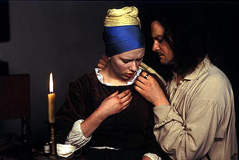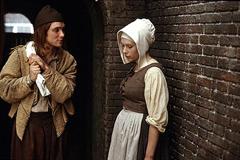Girl With a Pearl Earring (Peter Webber, 2003)
 In theory, viewing Peter Webber’s Girl
With a Pearl Earring might sound about as enticing as watching paint dry. It
tells a fictionalized tale of art history involving famed 17th century Dutch
painter Johannes Vermeer (Colin Firth) and Griet (Scarlett Johansson), the
peasant girl who inspires him to create his masterpiece. Its story of romantic
repression and artistic inspiration is somewhat trite, especially in comparison
to a superior film about painting like Jacques Rivette’s La Belle Noiseuse.
As much as we understand Griet’s motivations, Vermeer himself remains
something of a cipher, and as such, the film misses an opportunity to provide
added insight into the artist’s mind and work. Nonetheless, in the telling of
its tale, it manages at once to be surprisingly understated, but at the same
time so passionately realized by Webber and his team, that its clichés are easy
to forgive. Webber creates a convincing, cloistered environment in which the
mere brush of another’s hand carries a mighty charge.
In theory, viewing Peter Webber’s Girl
With a Pearl Earring might sound about as enticing as watching paint dry. It
tells a fictionalized tale of art history involving famed 17th century Dutch
painter Johannes Vermeer (Colin Firth) and Griet (Scarlett Johansson), the
peasant girl who inspires him to create his masterpiece. Its story of romantic
repression and artistic inspiration is somewhat trite, especially in comparison
to a superior film about painting like Jacques Rivette’s La Belle Noiseuse.
As much as we understand Griet’s motivations, Vermeer himself remains
something of a cipher, and as such, the film misses an opportunity to provide
added insight into the artist’s mind and work. Nonetheless, in the telling of
its tale, it manages at once to be surprisingly understated, but at the same
time so passionately realized by Webber and his team, that its clichés are easy
to forgive. Webber creates a convincing, cloistered environment in which the
mere brush of another’s hand carries a mighty charge.
 The director, like the painter in the
film, seems to have found a muse in Griet. As played by Johansson, her face
becomes a canvas onto which Webber casts sexual desire, intellectual curiosity,
and the self-recrimination of her character’s lower class. Most of the
thematic material that the slim, but attractive, Girl houses springs
forth from watching Griet as she goes about her duties and tries to locate a
safe place within her new household’s power struggle. Without speaking much at
all, Johansson manages to convey the difficulties of Griet’s position, both
emotional and physical. Furthermore, the talented young actress is able to
become the compelling object of erotic obsession while purposely suppressing her
striking looks. Thanks to a constraining uniform and makeup that warrants
comparisons to Cate Blanchett’s radical transformation into Elizabeth,
Johansson’s Griet is a being that seems to exist entirely in the past.
The director, like the painter in the
film, seems to have found a muse in Griet. As played by Johansson, her face
becomes a canvas onto which Webber casts sexual desire, intellectual curiosity,
and the self-recrimination of her character’s lower class. Most of the
thematic material that the slim, but attractive, Girl houses springs
forth from watching Griet as she goes about her duties and tries to locate a
safe place within her new household’s power struggle. Without speaking much at
all, Johansson manages to convey the difficulties of Griet’s position, both
emotional and physical. Furthermore, the talented young actress is able to
become the compelling object of erotic obsession while purposely suppressing her
striking looks. Thanks to a constraining uniform and makeup that warrants
comparisons to Cate Blanchett’s radical transformation into Elizabeth,
Johansson’s Griet is a being that seems to exist entirely in the past.
 Eduardo Serra’s cinematography is
exquisite, especially once one grows accustomed to the artifice inherent in the
film’s photographic approach. Exaggerated light and shadows and striking
compositions are used to heighten reality, giving the movie’s visuals the
veneer of a Vermeer painting. This stylistic choice admirably puts the film’s
environment at a mild remove from the authentic, which lessens the negative
impact one might feel when it becomes apparent that the vast majority of the
action occurs in one small home. What is perhaps most striking about the
film’s look, however, is that the detail and artistry of the Vermeer paintings
that are shown (which are both actual and recreated) seems more vivid than the
shots of reality. For all of its pretense and reverence, it is humble of Girl
to recognize that it exists in the service of a greater artist’s legend.
Eduardo Serra’s cinematography is
exquisite, especially once one grows accustomed to the artifice inherent in the
film’s photographic approach. Exaggerated light and shadows and striking
compositions are used to heighten reality, giving the movie’s visuals the
veneer of a Vermeer painting. This stylistic choice admirably puts the film’s
environment at a mild remove from the authentic, which lessens the negative
impact one might feel when it becomes apparent that the vast majority of the
action occurs in one small home. What is perhaps most striking about the
film’s look, however, is that the detail and artistry of the Vermeer paintings
that are shown (which are both actual and recreated) seems more vivid than the
shots of reality. For all of its pretense and reverence, it is humble of Girl
to recognize that it exists in the service of a greater artist’s legend.
70
12-14-03
Jeremy Heilman